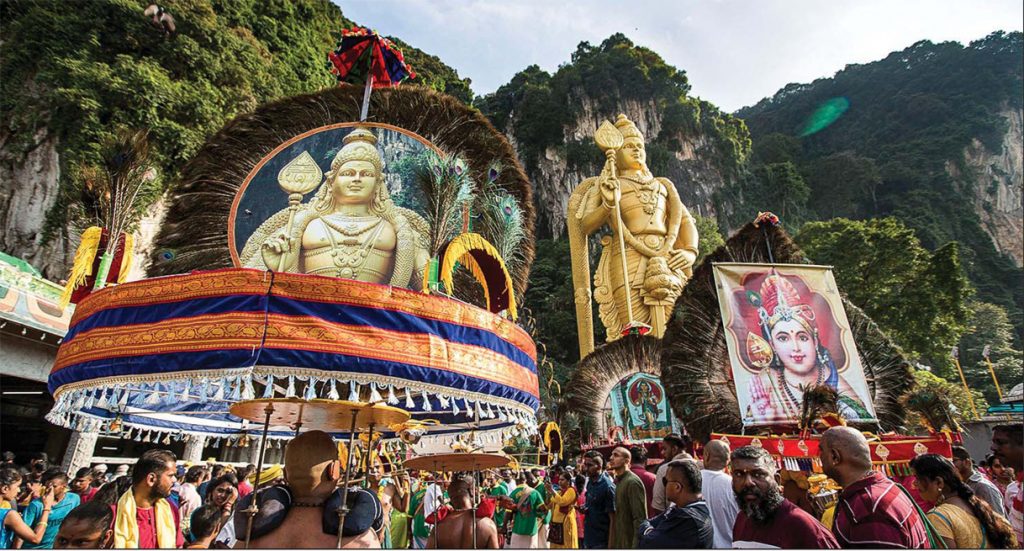Download the full-color, newspaper-page-size PDF of this special festival feature from our Festival Pager Downloads
By many names we known Him. He is Murugan, the beautiful one. He is Dandapani, the God of yoga who guides us on the path to Self Realization. He is Kumara, the God of child-like love, holding steady the higher realms of creation. He is Karttikeya, the God of war, who arrives to end all conflicts with piercing wisdom and swift action. During January/February, the Tamil month of Thai, millions gather to worship and honor Him with fervor. In North America, He has temples in Arizona, Maryland, Toronto, Montreal, Vancouver and California.
HOW IS THAI PUSAM CELEBRATED?
Devotees prepare themselves through prayer and fasting. On the day of the festival, many shave their heads, an act of sacrifice that symbolizes humility and the surrender of vanity. They undertake a pilgrimage to a place where Thai Pusam is being celebrated, usually a temple, while performing acts of devotion and penance. The most notable practices are the carrying of kavadis (“burdens”). Thai Pusam is observed in the Tamil month of Thai, between January 15 and February 15, when the Pushya star cluster, called Pusam in Tamil, rises with the full moon.
WHAT IS KAVADI?
Kavadi is an offering carried by a devotee during a grand parade and offered to Murugan at the destination. The most common, pal kudam, is a pot filled with milk carried over one’s head. Less common but more impressive are the bamboo structures formed like a peacock or chariot, ornamented with symbols evocative of Murugan. Some are heavy structures many feet tall and covered in peacock feathers. For weeks before the festival, kavadi carriers observe celibacy, take only fresh, light foods, while striving to think continuously of the Deity. Just before the sacred walk, they take a vow and pray for boons, often pledging some form of sacrifice or change in behavior. During the ordeal, many experience states of euphoria or trance.
WHAT IS THE PURPOSE OF KAVADI?
Austerity strengthens willpower, clears the mind of regrets, resolves problems and brings closeness to God. Devotees believe that God will make any burden seem weightless as long as their faith is firm. Kavadi is the highest form of offering, a gift to God of personal effort and sacrifice.
WHAT IS THAI PUSAM’S SPECIAL SIGNIFICANCE?
This festival celebrates the moment in sacred legends when Lord Murugan, as the commander-in-chief of the divine army, defeated, using various spiritual powers, a mighty demon named Taraka who was wreaking havoc in all the worlds.
WHERE IS THAI PUSAM CELEBRATED?
This festival is widely celebrated among communities of Tamil peoples in South India, Sri Lanka, Malaysia, Fiji, South Africa, Singapore, Mauritius, the Caribbean and North America. In South India, thousands walk barefoot for days to Palani Hills carrying colorful kavadis. The largest celebrations take place in Malaysia, where it is a public holiday. The temple at Batu Caves, near Kuala Lumpur, attracts a million devotees on that day.
TIDBITS ABOUT THAI PUSAM
What other acts of penance are observed? After fasting and following other spiritual preparations, carriers of kavadi may ask a priest to pierce their bodies with small spears, replicas of Lord Murugan’s vel. Other famous acts of penance include walking on hot coals and wearing nail shoes. It is considered a miracle of faith that fire walkers suffer no burns, and piercings do not bleed or leave scars.
Why are these austerities performed? Fasting, head-shaving and kavadi are acts of devotion and penance to atone for misdeeds, earn spiritual merit and subdue the ego. Such austerities soften and relieve the burdens of karma, guilt, regret and troublesome memories. Through sacred rites and intense prayers, the Deity’s soothing blessings are received into the nerve system of the devotee. Penance, sincerely performed with the help of the angelic worlds, heals mental-emotional wounds and grants release from suffering.
GOD LOVES A PARADE
Hindu festivals often feature a grand parade in which the Deity is taken through the streets. The procession attracts huge crowds, energizing devotees and bringing God’s blessings out to the city from the confines of the temple. It is not the temple’s main Deity image that is paraded, but a smaller statue or symbol. An ornate chariot built of wood and silver is pulled with huge ropes by throngs of devotees. The procession in Kuala Lumpur begins in the heart of the city and proceeds 15 kilometers–a slow, 8-hour journey–to Batu Caves. There the Deity is carried up the flight of 272 steps to the Murugan shrine inside the cave.
HINDUISM: FACT & FICTION
FACT: Devotees who receive piercings and undergo other self-inflicting austerities during Thai Pusam do not bleed, suffer infections or experience prolonged pain after the events. Fasting, herbal salves, celibacy and a trance-like, exalted state mitigate human suffering commonly experienced when such practices are carried out unsupervised. Those who express devotion in such extreme ways are accorded reverential respect by the community.
FICTION: Many people believe that karma means “fate,” a preordained destiny over which one has no control. This is untrue. Karma is the process of action and reaction on all levels–physical, mental and spiritual. We each have the power to remold our future by the way we live now. If we sow goodness, we will reap goodness; if we sow evil, we will reap evil.
